The ASUS Maximus VIII Extreme Review: The Other $500 Option
by Ian Cutress on April 7, 2016 9:00 AM EST- Posted in
- Motherboards
- Gaming
- Asus
- ROG
- Skylake
- Z170
- Thunderbolt 3
System Performance
Not all motherboards are created equal. On the face of it, they should all perform the same and differ only in the functionality they provide - however this is not the case. The obvious pointers are power consumption, but also the ability for the manufacturer to optimize USB speed, audio quality (based on audio codec), POST time and latency. This can come down to manufacturing process and prowess, so these are tested.
Power Consumption
Power consumption was tested on the system while in a single MSI GTX 770 Lightning GPU configuration with a wall meter connected to the OCZ 1250W power supply. This power supply is Gold rated, and as I am in the UK on a 230-240 V supply, leads to ~75% efficiency > 50W, and 90%+ efficiency at 250W, suitable for both idle and multi-GPU loading. This method of power reading allows us to compare the power management of the UEFI and the board to supply components with power under load, and includes typical PSU losses due to efficiency. These are the real world values that consumers may expect from a typical system (minus the monitor) using this motherboard.
While this method for power measurement may not be ideal, and you feel these numbers are not representative due to the high wattage power supply being used (we use the same PSU to remain consistent over a series of reviews, and the fact that some boards on our test bed get tested with three or four high powered GPUs), the important point to take away is the relationship between the numbers. These boards are all under the same conditions, and thus the differences between them should be easy to spot.
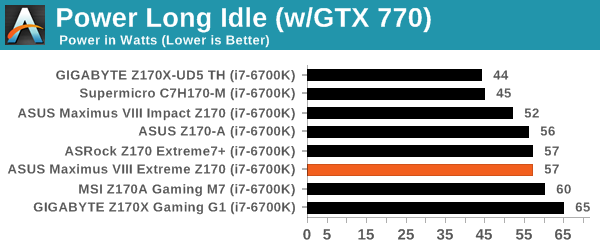
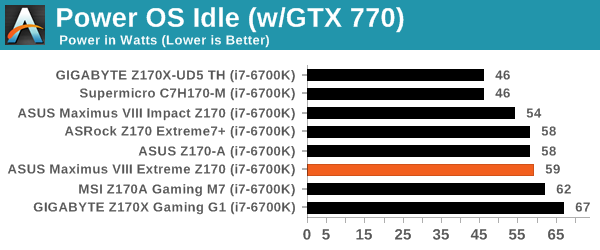
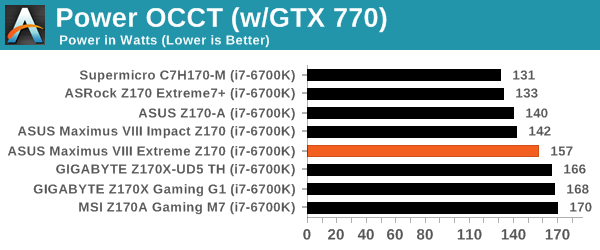
By the nature of being a large E-ATX motherboard with a number of extra controllers, one would expect the M8E to draw a fair bit of power, even under CPU load.
Non UEFI POST Time
Different motherboards have different POST sequences before an operating system is initialized. A lot of this is dependent on the board itself, and POST boot time is determined by the controllers on board (and the sequence of how those extras are organized). As part of our testing, we look at the POST Boot Time using a stopwatch. This is the time from pressing the ON button on the computer to when Windows 7 starts loading. (We discount Windows loading as it is highly variable given Windows specific features.)
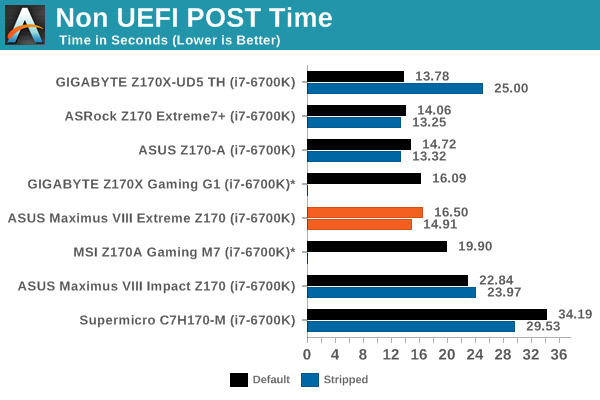
Perhaps due to the emergence of Windows 10 and fast boot sequences, fewer motherboard companies are worrying about POST times, although they are now arguably the longest part of a start-up process, especially with the additional DDR4 training needed for validation. The Extreme is reasonably comfortable for its size at 16.50 seconds.
Rightmark Audio Analyzer 6.2.5
Rightmark:AA indicates how well the sound system is built and isolated from electrical interference (either internally or externally). For this test we connect the Line Out to the Line In using a short six inch 3.5mm to 3.5mm high-quality jack, turn the OS speaker volume to 100%, and run the Rightmark default test suite at 192 kHz, 24-bit. The OS is tuned to 192 kHz/24-bit input and output, and the Line-In volume is adjusted until we have the best RMAA value in the mini-pretest. We look specifically at the Dynamic Range of the audio codec used on board, as well as the Total Harmonic Distortion + Noise.
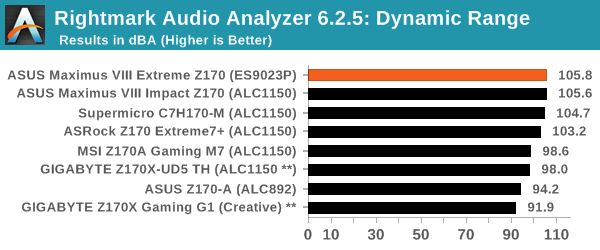

Audio performance from the Extreme gives it the highest SNR of any 100-series motherboard we’ve tested before.
USB Backup
For this benchmark, we transfer a set size of files from the SSD to the USB drive using DiskBench, which monitors the time taken to transfer. The files transferred are a 1.52 GB set of 2867 files across 320 folders – 95% of these files are small typical website files, and the rest (90% of the size) are small 30 second HD videos. In an update to pre-Z87 testing, we also run MaxCPU to load up one of the threads during the test which improves general performance up to 15% by causing all the internal pathways to run at full speed.
Due to the introduction of USB 3.1, as of June 2015 we are adjusting our test to use a dual mSATA USB 3.1 Type-C device which should be capable of saturating both USB 3.0 and USB 3.1 connections. We still use the same data set as before, but now use the new device. Results are shown as seconds taken to complete the data transfer.
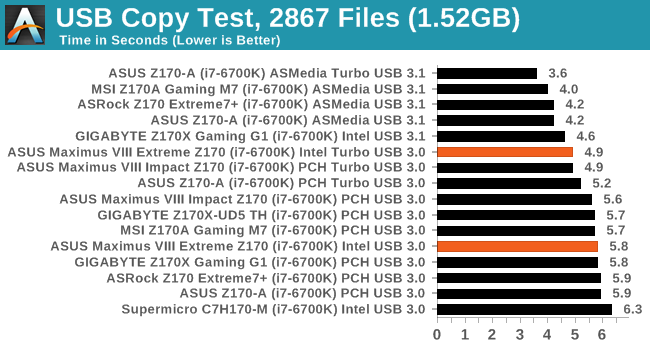
With ASUS’ USB Turbo, we get great performance in our USB 3.0 test. Unfortunately due to the nature of the Intel USB 3.1 controller, our testing software reports erroneous results stating that a transfer is complete faster than could be possible (and it’s a highly variable result). Interestingly we also had problems with the ASMedia controller, which behaved similarly.
DPC Latency
Deferred Procedure Call latency is a way in which Windows handles interrupt servicing. In order to wait for a processor to acknowledge the request, the system will queue all interrupt requests by priority. Critical interrupts will be handled as soon as possible, whereas lesser priority requests such as audio will be further down the line. If the audio device requires data, it will have to wait until the request is processed before the buffer is filled.
If the device drivers of higher priority components in a system are poorly implemented, this can cause delays in request scheduling and process time. This can lead to an empty audio buffer and characteristic audible pauses, pops and clicks. The DPC latency checker measures how much time is taken processing DPCs from driver invocation. The lower the value will result in better audio transfer at smaller buffer sizes. Results are measured in microseconds.
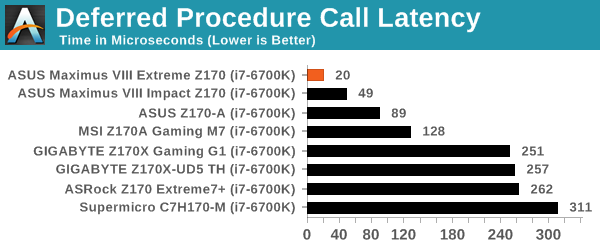
For better or worse, DPC Latency has been a wild ride on Z170. Some companies care deeply, others are not too fussed. Despite this, ASUS seems to have nailed down the formula for a great DPC Latency, and the Maximus VIII Extreme takes the crown from its smaller sibling in style.










70 Comments
View All Comments
Flunk - Thursday, April 7, 2016 - link
At that price point you really should be considering an X99-platform system. You're scraping the bottom of the barrel when it comes to diminishing returns.xthetenth - Thursday, April 7, 2016 - link
This board does make sense for people who need a set of high end features that precludes any other boards, but that's few and far between.dsumanik - Friday, April 8, 2016 - link
Lot of talking up the gigabyte 4 way SLI, which was never even tested... As a reviewer wouldn't you wonder if it even works? Curious about the performance? Isn't that the whole reason for this website? To see how the latest and greatest tech performs? Anyways 500 bucks. Nah.jameskatt - Saturday, May 14, 2016 - link
That is the whole point. ASUS makes this motherboard for the few and far between.Ubercake - Thursday, April 7, 2016 - link
I was thinking that same thing. Why are motherboards going up so much in cost when the Processors have taken over most if not all of what used to be the Northbridge functions?If anything the motherboards should be worth less than they were before because for the most part, they aren't providing as much functionality. Granted, some have better voltage control and over-clocking capability, but that shouldn't add much to the cost comparatively. And this isn't the enthusiast lineup either. Not sure what these companies expect.
willis936 - Thursday, April 7, 2016 - link
You don't want to see the BOM of a $500 non server board.jasonelmore - Thursday, April 7, 2016 - link
your paying for the software on most of this high dollar hardware stuff. i know you are probably no interested in that stuff, but asus see's it differently. their magins will always be more than Asrock, so they have to differentiate somehow.Medical equipment is notoriously overpriced for what it is, but it uses custom software that nobody else makes, so they can get away with jacking up the price 2000% over the bill of materials.
close - Friday, April 8, 2016 - link
Medical business is a different animal. The standards and certifications they have to meet/pass means even the basic functions must be implemented in a different (more expensive) way. Things that are acceptable on a consumer product might be totally unacceptable on a medical one where a BSOD might actually involve a death ;).The NB functions were integrated into the CPU but then again motherboards didn't always have 2 NICs, WiFi, tricked up audio, bundled OC panels, etc. And don't forget about the 80/20 rule. You get 80% or results with 20% of the cost but then hang on to your sit because the cherry on top comes at a price. Optimizing the board layout and traces costs and if you want it you'll have to dish out the $500. It's always been the same, the closer you get to the top the quicker the costs pile up.
I for one would never buy ROG again. Half of the stuff it offers is just wasted on me and I considered most features to be overkill and wasteful. I realized that after I started using (or not using) them. But then again there's always a market for this so why not? :)
jameskatt - Saturday, May 14, 2016 - link
If you want the best quality product, then you will pay for it. That is true of any product. The best ones generally take more work to create. It is not simply the cost of the goods to create it. The labor costs can be very high. If you are satisfied with lower quality, then so be it. But there are some who simply want the best and are willing to pay for it. A $500 motherboard is nothing compared to the $25,000+ cost of a high end PC which may include a $2000 CPU, $1200 GPU, $1000 SSD, $8000 data storage system, $5000 professional monitor, etc.chlamchowder - Thursday, April 7, 2016 - link
The processors that work with Z170 have a newer architecture and better performance per-core, while X99 can support processors with more cores (and tons of memory), but generally less per-core performance.It depends on what you need. Gaming, for example, still has trouble scaling even to four cores and can benefit quite a bit from more per-core performance. That said, spending $500 on a motherboard (X99 or Z170) is something I'll never understand.